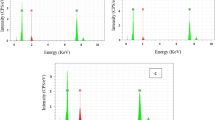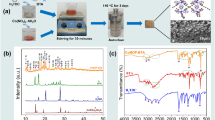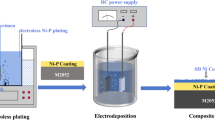Abstract
In this study, Cu-Ni-Si alloy was subjected to corrosion resistance tests under simulated high-temperature, high-pressure H2S and Cl− environments. The corrosion rates, electrochemical performance, surface morphologies, and chemical compositions of the Cu-Ni-Si alloy after corrosion were analyzed by the mass loss method, electrochemical impedance spectroscopy, scanning electron microscopy, energy-dispersive x-ray spectrometry, and x-ray diffraction. The results showed that, at the initial stage of corrosion, because of the loose corrosion product layer initially formed on the surface, a high corrosion rate was observed for the Cu-Ni-Si alloy under high-temperature, high-pressure environments. With the progress of corrosion, the corrosion rate gradually decreased and reached a steady state. Because at the later stage, a passive film was formed on the alloy surface, further inhibiting the corrosion of the alloy and improved its corrosion resistance. The Cu-Ni-Si alloy exhibited good corrosion resistance under high-temperature, high-pressure H2S and Cl− environments.










Similar content being viewed by others
References
M.C. Suárez-Arriaga, J. Bundschuh, and F. Samaniego, Assessment of Submarine Geothermal Resources and Development of Tools to Quantify Their Energy Potentials for Environmentally Sustainable Development, J. Clean. Prod., 2014, 83, p 21–32
M. Ren, J.P. Chen, and S. Zhang, Metallogenic Information Extraction and Quantitative Prediction Process of Seafloor Massive Sulfide Resources in the Southwest Indian Ocean, Ore Geol. Rev., 2016, 76, p 108–121
C.G. Wheat, A.T. Fisher, J.M. Manus, S.M. Hulme, and B.N. Orcutt, Cool Seafloor Hydrothermal Springs Reveal Global Geochemical Fluxes, Earth Planet. Sci. Lett., 2017, 476, p 179–188
V.M. Dekov, L. Bindi, G. Burgaud, S. Petersen, D. Asael, V. Rédou, Y. Fouquet, and B. Pracejus, Inorganic and Biogenic As-Sulfide Precipitation at Seafloor Hydrothermal Fields, Mar. Geol., 2013, 342, p 28–38
S. Gollner, B. Govenar, P.M. Arbizu, S. Mills, N.L. Bris, M. Weinbauer, T.M. Shank, and M. Bright, Difference in Recovery Between Deep-Sea Hydrothermal Vent and Vent-Proximate Communities After a Volcanic Eruption, Deep-Sea Res. Part I, 2015, 106(12), p 167–182
A. Khripounoff, J.C. Caprais, C. Decker, J.L. Bruchec, P. Noel, and B. Husson, Respiration of Bivalves from Three Different Deep-Sea Areas: Cold Seeps, Hydrothermal Vents and Organic Carbon-Rich Sediments, Deep-Sea Res. Part II, 2017, 142(8), p 233–243
Q. Lei, Z. Li, Z.Y. Pan, M.P. Wang, Z. Xiao, and C. Chen, Dynamics of Phase Transformation of Cu-Ni-Si Alloy with Super-High Strength and High Conductivity During Aging, Trans. Nonferr. Met. Soc., 2010, 20(6), p 1006–1011
W.H. Sun, H.H. Xu, S.H. Liu, Y. Du, Z.H. Yuan, and B.Y. Huang, Phase Equilibria of the Cu-Ni-Si System at 700 °C, J. Alloys Compd., 2011, 509(41), p 9776–9781
Q. Lei, Z. Li, T. Xiao, Y. Pang, Z.Q. Xiang, W.T. Qiu, and Z. Xiao, A New Ultrahigh Strength Cu-Ni-Si Alloy, Intermetallics, 2013, 42(12), p 77–84
D. Božić, O. Dimčić, B. Dimčić, I. Cvijović, and V. Rajković, The Combination of Precipitation and Dispersion Hardening in Powder Metallurgy Produced Cu-Ti-Si Alloy, Mater. Charact., 2008, 59(8), p 1122–1126
J.K. Lee, On the Effect of Substituting Copper Powder with Cupric Salt for the Sintering Process of W-Cu MIM Parts, Int. J. Refract. Met. Hard Mater., 2008, 26(4), p 290–294
Y.K. Abdel, H.L. Faycal, A. Hiba, B. Thierry, B. Francois, A.L. Helbert, M.H. Mathon, K. Megumi, B. Djamel, and G. Terence, Microstructures and Textures of a Cu-Ni-Si Alloy Processed by High-Pressure Torsion, J. Alloys Compd., 2013, 574(10), p 361–367
X.H. Zhao, Y. Han, Z.Q. Bai, and B. Wei, The Experiment Research of Corrosion Behaviour About Ni-Based Alloys in Simulant Solution Containing H2S/CO2, Electrochim. Acta, 2011, 56(22), p 7725–7731
H.W. Wang, P. Zhou, S.W. Huang, and C. Yu, Corrosion Mechanism of Low Alloy Steel in NaCl Solution with CO2 and H2S, Int. J. Electrochem. Sci., 2016, 11(2), p 1293–1309
Z.Y. Liu, X.Z. Wang, R.K. Liu, C.W. Du, and X.G. Li, Electrochemical and Sulfide Stress Corrosion Cracking Behaviors of Tubing Steels in a H2S/CO2 Annular Environment, J. Mater. Eng. Perform., 2014, 23(4), p 1279–1287
X.Y. Tang, S.Z. Wang, L.L. Qian, Y.H. Li, Z.H. Lin, D.H. Xu, and Y.P. Zhang, Corrosion Behavior of Nickel Base Alloys, Stainless Steel and Titanium Alloy in Supercritical Water Containing Chloride, Phosphate and Oxygen, Chem. Eng. Res. Des., 2015, 100, p 530–541
E.H. Han, J.Q. Wang, X.Q. Wu, and W. Ke, Corrosion Mechanism of Stainless Steel and Nickel Base Alloys in High Temperature High Pressure Water, Acta Metall. Sin., 2010, 46(11), p 1370–1390
P. Kritzer, Corrosion in High-Temperature and Supercritical Water and Aqueous Solutions: A Review, J. Supercrit. Fluid, 2004, 29(1-2), p 1–29
X. Qi, H.H. Mao, and Y.T. Yang, Corrosion Behavior of Nitrogen Alloyed Martensitic Stainless Steel in Chloride Containing Solutions, Corros. Sci., 2017, 120, p 90–98
H.P. Seifert and S. Ritter, The Influence of ppb Levels of Chloride Impurities on the Strain-Induced Corrosion Cracking and Corrosion Fatigue Crack Growth Behavior of Low-Alloy Steels Under Simulated Boiling Water Reactor Conditions, Corros. Sci., 2016, 108, p 148–159
J. Wang, Z.Y. Wang, and W. Ke, A Study of the Evolution of Rust on Weathering Steel Submitted to the Qinghai Salt Lake Atmospheric Corrosion, Mater. Chem. Phys., 2013, 139(1), p 225–232
H. Katayama and S. Kuroda, Long-Term Atmospheric Corrosion Properties of Thermally Sprayed Zn, Al and Zn-Al Coatings Exposed in a Coastal Area, Corros. Sci., 2013, 76(2), p 35–41
J. Chen, Z. Qin, and D.W. Shoesmith, Kinetics of Corrosion Film Growth on Copper in Neutral Chloride Solutions Containing Small Concentrations of Sulfide, J. Electrochem. Soc., 2010, 157(10), p C338–C345
T. Martino and R. Partovi, Mechanisms of Film Growth on Copper in Aqueous Solutions Containing Sulphide and Chloride Under Voltammetric Conditions, Electrochim. Acta, 2014, 127(5), p 439–447
X.T. Chang, S.G. Chen, G.H. Gao, Y.S. Yin, S. Cheng, and T. Liu, Electrochemical Behavior of Microbiologically Influenced Corrosion on Fe3Al in Marine Environment, Acta Metall. Sin., 2009, 22(4), p 313–320
I. Milošev and H.M. Metikoš, The Behaviour of Cu-xNi (x = 10 to 40 wt.%) Alloys in Alkaline Solutions Containing Chloride Ions, Electrochim. Acta, 1997, 42(10), p 1537–1548
Acknowledgments
The authors acknowledge the financial support of the National Key Research and Development Program (No. 2016YFB0300700); National Natural Science Foundation (Nos. 51609133 and 5162195); and the China Postdoctoral Science Foundation (No. 2017M620153).
Author information
Authors and Affiliations
Corresponding author
Rights and permissions
About this article
Cite this article
Shen, Y., Dong, Y., Li, H. et al. Corrosion Resistance of Cu-Ni-Si Alloy Under High-Temperature, High-Pressure H2S and Cl− Environments. J. of Materi Eng and Perform 28, 1040–1048 (2019). https://doi.org/10.1007/s11665-018-3663-5
Received:
Revised:
Published:
Issue Date:
DOI: https://doi.org/10.1007/s11665-018-3663-5




